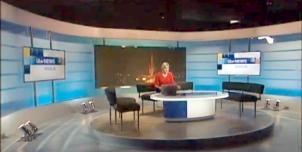Full Freeview on the Tacolneston (Norfolk, England) transmitter
| Google Streetview | Google map | Bing map | Google Earth | 52.518,1.139 or 52°31'6"N 1°8'22"E | NR16 1DW |
The symbol shows the location of the Tacolneston (Norfolk, England) transmitter which serves 330,000 homes. The bright green areas shown where the signal from this transmitter is strong, dark green areas are poorer signals. Those parts shown in yellow may have interference on the same frequency from other masts.
This transmitter has no current reported problems
The BBC and Digital UK report there are no faults or engineering work on the Tacolneston (Norfolk, England) transmitter._______
Digital television services are broadcast on a multiplexes (or Mux) where many stations occupy a single broadcast frequency, as shown below.
64QAM 8K 3/4 27.1Mb/s DVB-T MPEG2
DTG-12 QSPK 8K 3/4 8.0Mb/s DVB-T MPEG2
H/V: aerial position (horizontal or vertical)
Which Freeview channels does the Tacolneston transmitter broadcast?
If you have any kind of Freeview fault, follow this Freeview reset procedure first.Digital television services are broadcast on a multiplexes (or Mux) where many stations occupy a single broadcast frequency, as shown below.
64QAM 8K 3/4 27.1Mb/s DVB-T MPEG2
DTG-12 QSPK 8K 3/4 8.0Mb/s DVB-T MPEG2
H/V: aerial position (horizontal or vertical)
Which BBC and ITV regional news can I watch from the Tacolneston transmitter?

BBC Look East (East) 0.8m homes 3.2%
from Norwich NR2 1BH, 16km northeast (37°)
to BBC East region - 27 masts.
70% of BBC East (East) and BBC East (West) is shared output

ITV Anglia News 0.8m homes 3.2%
from NORWICH NR1 3JG, 16km northeast (38°)
to ITV Anglia (East) region - 26 masts.
All of lunch, weekend and 80% evening news is shared with Anglia (West)
Are there any self-help relays?
| Gt Yarmouth | Transposer | 1 km S town centre | 30 homes |
| Lowestoft (2) | Transposer | Rotterdam Rd | 125 homes |
How will the Tacolneston (Norfolk, England) transmission frequencies change over time?
| 1950s-80s | 1984-97 | 1997-98 | 1998-2011 | 2011-13 | 2013-18 | 2013-17 | 17 Jul 2018 | ||
| VHF | C/D E | C/D E | C/D E | E | E T | W T | W T | ||
| C3 | BBCtvwaves | ||||||||
| C31 | com7 | com7 | |||||||
| C32 | _local | ||||||||
| C37 | com8 | com8 | |||||||
| C39 | +ArqB | +ArqB | ArqB | ||||||
| C40 | BBCA | ||||||||
| C42 | SDN | SDN | SDN | SDN | |||||
| C43 | D3+4 | ||||||||
| C45 | ArqA | ArqA | ArqA | ArqA | |||||
| C46 | BBCB | ||||||||
| C50tv_off | BBCB | BBCB | |||||||
| C52tv_off | C5waves | C5waves | |||||||
| C55tv_off | BBC2waves | BBC2waves | BBC2waves | -BBCA | -BBCA | -BBCA | com7tv_off | ||
| C56tv_off | COM8tv_off | ||||||||
| C57tv_off | LNR | LNR | |||||||
| C59tv_off | ITVwaves | ITVwaves | ITVwaves | -D3+4 | -D3+4 | -D3+4 | |||
| C62 | BBC1waves | BBC1waves | BBC1waves | BBCB | |||||
| C65 | C4waves | C4waves | C4waves |
tv_off Being removed from Freeview (for 5G use) after November 2020 / June 2022 - more
Table shows multiplexes names see this article;
green background for transmission frequencies
Notes: + and - denote 166kHz offset; aerial group are shown as A B C/D E K W T
waves denotes analogue; digital switchover was 9 Nov 11 and 23 Nov 11.
How do the old analogue and currrent digital signal levels compare?
| Analogue 1-4 | 250kW | |
| SDN, ARQA, ARQB, BBCA, D3+4, BBCB | (-4dB) 100kW | |
| com7 | (-9.6dB) 27.4kW | |
| com8 | (-10.2dB) 24kW | |
| Mux 1*, Mux 2*, LNR | (-14dB) 10kW | |
| Mux A*, Mux B*, Mux C*, Mux D* | (-17dB) 5kW | |
| Analogue 5 | (-18dB) 4kW |
Local transmitter maps
Tacolneston Freeview Tacolneston DAB Tacolneston TV region BBC East Anglia (East micro region)Which companies have run the Channel 3 services in the Tacolneston transmitter area
|
|
Friday, 29 July 2011
J
jb386:33 PM
Lowestoft
Jane Hore: Looking at the trade reception predictor indicates to me that you are obviously if a very iffy area for reception, as none of the indications seen for your post code would fill me with confidence, Mux1 (Ch63) BBC1 etc being about the best, Ch's 61 & 58 (Mux C & B) also being in the green although not as good as Ch63, however the other unfortunate aspect is that the main ITV1 Mux2 transmitter (Ch60) is shown as giving variable reception, this along with MuxA Ch53 & MuxD Ch64.
The reason I say not filling me with confidence is because conditions do vary quite considerably over relatively short distances where you are located, to give a few examples, Oulton Broad library @ NR32 3LR shows reception of only one Mux (Ch63) as possible, with it being poor, Lowestoft Library @ NR32 1DR shows the possibility of three Mux's (Ch63-61-58) but with all being poor, and even although your post code does give better indications in practical terms I would consider these as only slight, and as such not reliable, so to me what you report would not be entirely unexpected, as in my experience these predictors are inclined to err on the side of the fanciful!
You will have to wait until the 23rd of November before the situation is liable to change for the better, that being what is indicated on the predictor anyway!
| link to this comment |
jb38's: mapJ's Freeview map terrainJ's terrain plot wavesJ's frequency data J's Freeview Detailed Coverage
Saturday, 30 July 2011
J
jane hore12:19 PM
@jb38
Whilst I know a 'lux' is a measurement of light emitted by a lamp I have no idea what a 'Mux' is. However as I can see Oulton Broad library, 200m across Lake Lothing, I guess I have to put up with its one Mux reading.
I await November 23 with heightened anticipation!
Thank you
| link to this comment |
J
jb382:46 PM
jane hore: Sorry about having caused you confusion on that!
RF channels transmitted on a Digital transmitter are called Multiplexes or Mux for short, as each Multiplex channel contains a variety of programme channels, this unlike analogue where one RF transmitter channel = one programme, and in your case there are six Digital Mux channels.
People located in areas of bad reception usually always receive some Mux channels much better than others (or some not at all!) and its these individual transmitter channels I was meaning when I mentioned the various Mux channels and what their reception possibilities are shown as being.
November 23rd does indicate a better situation existing "on the trade predictor" for your location, but as I previously mentioned predictors of any sort can never really cater properly for local conditions, and indeed its quite impossible for anyone to accurately predict in cases like that as nothing beats a site visit.
However come the end of November and you still have problems then I cant really see anything other than Freesat rectifying the situation, as the situation seen at the end of November carries on into 2013 at the end of the chart.
| link to this comment |
Monday, 1 August 2011
J
Jm F1:33 PM
jame hore: many of the failures like yours are caused by a dodgy coax cable from the wall socket to the TV set (especially if the TV is wall mounted and the coax cable has a tight bend close to the connector).
Try a different coax cable and see if that helps.
| link to this comment |
Tuesday, 2 August 2011
jane hore: "mux" = multiplex. See How digital television works | ukfree.tv - independent free digital TV advice (part 5).
| link to this comment |
Thursday, 4 August 2011
P
Pierre12:51 PM
Briantist: Thank you for your message. I've checked the frequencies. I'll check the orientation.
| link to this comment |
Friday, 5 August 2011
A
Alan7:14 AM
Reading notes above it states Mux2 moves to ch59 on 17 August. I am intrigued to know how this will not make the signal on ITV1 Analogue also on ch59 not go very snowy.
| link to this comment |
Alan: I think the idea is that ITV1 analogue closes a few months early.
| link to this comment |
M
Mike Dimmick1:35 PM
Briantist: I'd been meaning to mention that. I'm certain they will not shut down ITV1 analogue early.
There will be some clashing with Belmont C60 but that has been handled by delaying power-up - it will double to 8 kW at DSO2. Hemel Hempstead will release C60 for Oxford on 14 September; this is a PSB channel at Oxford, launching at full power (100kW). It's already an analogue frequency there, so there might be a small net reduction in interference at TAC for the last couple of months.
There's a note in the 'Supplementary License Documents for DSO' version 3 that says, for Mux 2, "until 17 August 2010 services will be provided on channel 60". If we assume that 2010 should read 2011, it does match where Mux 2 is now, and the date that Mux B moves from C58 to C66, and Mux C from C61 to C68. I have to assume that this note is just complete rubbish.
The document does not mention the Mux B and C retunes at all. It does seem to indicate a power increase to 10kW on Mux A at some point between now and DSO2, or that could just be more rubbish.
There is a version 4 document now at http://licensing.ofcom.org.uk/binaries/tv/sup_dso/digital-stations-v4.pdf which looks like it has the same notes, but for Mux 2 the rows of the spreadsheet are too short and only the first line is visible.
Ofcom are really, really failing with switchover. They're letting the broadcasters do whatever they want and not keeping up with the paperwork.
The best source of information seems to be the 'Trade Region' section of DUK's postcode checker at Postcode Checker - Trade View , though that doesn't include power levels.
| link to this comment |
D
DAVE4:41 PM
Thetford
I am thinking of buying a indoor freeveiw Ariel, i live in watton ip256ba about 15 miles from the tacolneston transmitter, will this be strong enough to pick up freeveiw channels, thanks, Dave.
| link to this comment |
DAVE's: ...
Select more comments
Your comment please!





